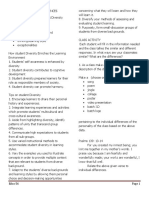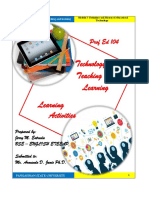Module 13
Uploaded by
Mary Grace BatalModule 13
Uploaded by
Mary Grace BatalMARY GRACE B.
BATAL ED203-E
2nd Year- BPED
MODULE 13
ASSESSMENT TASK:
1) Describe the development of the child’s ability to represent
knowledge.
Enactive representation
➢ Is the first stage of representation, beginning in infancy, in which a child's world is
represented through objects in terms of their immediate sensations of them. For
example, their muscular and motor reactions, as well as the manner in which they
affect their surroundings.
Iconic representation
➢ begins at the age of two to three years old and entails the creation of mental images that reflect
certain objects or events; imagery that is mostly action-free.
Symbolic representation
➢ is the ability to turn action and image into a symbolic system to encode knowledge,
which emerges around the age of seven. Language and mathematical notation are the
most common symbols.
2) Explain how the spiral curriculum works.
➢ Learning is spread out throughout time rather than concentrated in shorter times in a spiral
curriculum. In a spiral curriculum, material is addressed several times over the course of months and
grades. A spiral technique is typically contrasted with "blocked" or "massed" approaches, and several
names are used to characterize it, including "distributed" and "spaced." Learning is concentrated in
continuous blocks in a massed method. Massing is more frequent than spacing in the design of
instructional materials.
You might also like
- Research Connection Read A Research or Study Related To Students' Diversity in Motivation. Fill Out The Matrix BelowNo ratings yetResearch Connection Read A Research or Study Related To Students' Diversity in Motivation. Fill Out The Matrix Below4 pages
- Facilitating Learner-Centered Teaching Module 11 - Gagne's Conditions of Learning Moscoso, Roselyn C. Beed-Lll Learning OutcomesNo ratings yetFacilitating Learner-Centered Teaching Module 11 - Gagne's Conditions of Learning Moscoso, Roselyn C. Beed-Lll Learning Outcomes2 pages
- Pangasinan State University Sta. Maria Campus Sta. Maria, PangasinanNo ratings yetPangasinan State University Sta. Maria Campus Sta. Maria, Pangasinan4 pages
- Module 6 Facilitating Learner Centered TeachingNo ratings yetModule 6 Facilitating Learner Centered Teaching5 pages
- Measurement, Assessment and Evaluation in Outcomes-Based EducationNo ratings yetMeasurement, Assessment and Evaluation in Outcomes-Based Education3 pages
- A. List Down Three (3) Supporting Student Activities To Attain Each of The Identified Student LearningNo ratings yetA. List Down Three (3) Supporting Student Activities To Attain Each of The Identified Student Learning6 pages
- Students at All Levels. Their Duties Include Assigning Homework, Grading Tests, andNo ratings yetStudents at All Levels. Their Duties Include Assigning Homework, Grading Tests, and2 pages
- Learners With Exceptionalities: Course, Year, Section: BCAED 2No ratings yetLearners With Exceptionalities: Course, Year, Section: BCAED 23 pages
- Pre Schoolers Symbolic and Intuitive Thinking MitNo ratings yetPre Schoolers Symbolic and Intuitive Thinking Mit10 pages
- Focus On The Learner Review of The Development TheoriesNo ratings yetFocus On The Learner Review of The Development Theories16 pages
- ProfEd 104 Technology For Teaching and Learning50% (2)ProfEd 104 Technology For Teaching and Learning28 pages
- LA - 1 - Module1 1 - ANGELIKA MENDOZA BEED1ANo ratings yetLA - 1 - Module1 1 - ANGELIKA MENDOZA BEED1A3 pages
- This Study Resource Was: Facilitating Learner-Centered Teaching '100% (1)This Study Resource Was: Facilitating Learner-Centered Teaching '3 pages
- Educ 5 Importance of Teaching Learning ProcessNo ratings yetEduc 5 Importance of Teaching Learning Process2 pages
- Theory 2 - Teaching As A Vocation and MissionNo ratings yetTheory 2 - Teaching As A Vocation and Mission5 pages
- EDUC 100 Cognitive Development of PreschoolersNo ratings yetEDUC 100 Cognitive Development of Preschoolers11 pages
- MODULE 1 LESSON 1 Pretest Checklist Activities 1.1-1.10No ratings yetMODULE 1 LESSON 1 Pretest Checklist Activities 1.1-1.1019 pages
- (ED 12) The Teaching Profession: Prepared by100% (1)(ED 12) The Teaching Profession: Prepared by27 pages
- Source: (Bibliographical Entry Format) - M/2017/01/23/research-Works-Study-Related-To-Learner-Centered - Psychological-Principle-LcpNo ratings yetSource: (Bibliographical Entry Format) - M/2017/01/23/research-Works-Study-Related-To-Learner-Centered - Psychological-Principle-Lcp2 pages
- Bigael, Jestoni A. - Module 1 (The Philosophical, Historical,) OutputsNo ratings yetBigael, Jestoni A. - Module 1 (The Philosophical, Historical,) Outputs6 pages
- by Means of Graphic Organizer Present The Basic Categories of Exceptional Learners and Describe Each Category Briefly100% (3)by Means of Graphic Organizer Present The Basic Categories of Exceptional Learners and Describe Each Category Briefly1 page
- Characteristics of Young Learners Learning StylesNo ratings yetCharacteristics of Young Learners Learning Styles10 pages
- BA302-International Business and Trade I. Identification. Write Iin All Upper Case LetterNo ratings yetBA302-International Business and Trade I. Identification. Write Iin All Upper Case Letter4 pages































































